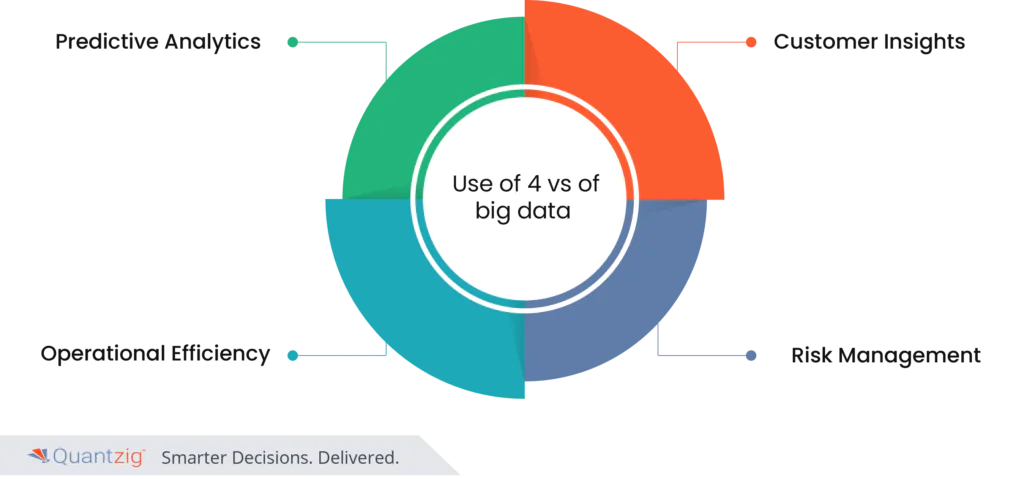Written by: Associate Vice President, Analytics and Data Strategy, Quantzig.
Ever wondered what truly qualifies as big data? At Quantzig, we know that to harness the power of data, you need more than just size. Big data is defined by five key traits: Volume, Velocity, Variety, Veracity, and the all-important Value. These pillars not only categorize big data but also unlock its potential to drive impactful decisions across your organization.
Quantzig have been delivering impactful results by making use of the Four Vs of Big Data to help their clients overcome the challenges.
Book a demo to experience the meaningful insights we derive from data through our data management analytical tools and platform capabilities.
Request a Free DemoTable of Contents
what are the Four vs of big data?
Big Data’s characteristics, often defined by the 4Vs—Volume, Velocity, Variety, and Veracity—are key to understanding its complexities and potential. At Quantzig, we harness a comprehensive Big Data Management Framework that incorporates these essential components to turn raw data into powerful insights. Data Volume reflects the vast amounts of information generated daily, while Velocity deals with the speed at which this data flows and is processed. Variety refers to the wide range of structured and unstructured data types, and Veracity ensures the trustworthiness and accuracy of the data. Together, these Big Data Dimensions are crucial to managing data effectively and addressing challenges like Big Data Processing Speed and quality control.
By applying the 4Vs in Data Science, Quantzig unlocks meaningful Big Data Insights to drive innovation and strategic decision-making. Our data solutions are designed to handle Data Variety and ensure accurate Big Data Analysis across diverse industries. With a focus on Big Data Quality Control using the 4Vs framework, we empower businesses to turn complex datasets into actionable insights. Partnering with Quantzig means your organization will benefit from cutting-edge analytics, enabling you to stay competitive through enhanced data-driven decisions.
Four Vs of Big Data with example: Deep Dive
Volume
Variety
Velocity
Veracity
In a world where data is the new currency, organizations must master the art of managing and securing vast amounts of information to stay ahead. Every day, we generate a staggering 2.5 quintillion bytes of data—captured through everything from our Google searches and online purchases to the photos we snap and the sensor data from IoT devices. But how do you determine if your data truly qualifies as “big”? The answer lies in the five Vs: Volume, Velocity, Variety, Veracity, and, crucially, Value.
Volume
It speaks to the sheer magnitude of data produced. Today, in just one minute, we create as much data as was generated from the dawn of civilization until the year 2000. To manage this immense volume, cutting-edge technologies and strategies like multitiered storage media have emerged, ensuring data is collected, analyzed, and stored securely.
Velocity
This refers to the speed at which data is generated and transmitted. From the moment you send a text, browse social media, or make a purchase, data is created that must be processed in real time. Multiply this by billions of global activities, and you see how speed is a defining feature of big data.
Variety
It captures the diverse types of data we now handle—structured, semi-structured, and unstructured. Unlike the neat rows and columns of a spreadsheet, today’s data includes text, images, videos, and more. Technologies now enable us to make sense of this complex, unstructured data, unlocking insights that were once out of reach.
Veracity
This is all about trustworthiness. With data flowing from countless sources, it’s essential to ensure accuracy and quality. Understanding the origin, context, and metadata of data is critical for extracting meaningful insights that drive strategic decisions.
Finally, Value is what ties it all together. Big data is only as powerful as the value it generates. Without a well-crafted data strategy that turns insights into action, companies risk falling behind. From enhancing customer understanding to optimizing operations, data’s true power lies in its ability to drive data-driven decision-making.
At Quantzig, we are experts in harnessing the full potential of big data, ensuring that organizations not only manage their data effectively but also extract maximum value to fuel growth and innovation.
Experience the advantages firsthand by testing a customized complimentary pilot designed to address your specific requirements. Pilot studies are non-committal in nature.
Request a Free PilotImportance of the Four vs of big data:
In the ever-evolving realm of business solution development and strategy, the significance of the four ‘V’s of big data—Volume, Velocity, Variety, and Veracity—cannot be overstated. These factors are pivotal in guiding companies as they strive to maneuver through the intricacies of the contemporary landscape.
Strategic Decision-Making through Real-Time Acquisition:
Real-time acquisition, a facet of the Velocity dimension, allows businesses to gain a competitive edge by accessing and analyzing data as it is generated. This capability is crucial for making informed business decisions promptly, especially in dynamic environments where GPS signals, photographs, and data points contribute to the ever-flowing stream of information. Companies leveraging real-time acquisition, whether through Automated public online collection, machine learning, or artificial intelligence, can adjust their strategies in response to unfolding phenomena, providing a distinct advantage in the fast-paced business landscape.
Optimization of Processes and Resources:
Efficiency, an overarching goal for any business, is significantly influenced by the three V's—Volume, Variety, and Velocity. Optimization involves strategically combining data from internal sources, external public sources, and Company-provided APIs, such as the Twitter API. Web scraping solutions, when used judiciously, contribute to the optimization process, ensuring that costs are managed effectively, and growth is sustained. Companies must prioritize the analysis of data from different sources, employing Absolute guidelines as a starting point to enhance efficiency and achieve optimal results.
Informed Decision-Making:
Veracity, the dimension emphasizing the reliability and accuracy of data, is paramount for making informed business decisions. Theoretical undertakings involving analytics technologies must translate into practical applications that maintain the quality of the data collected. The value lies in its accuracy and reliability. Companies must implement measures to minimize variance, prioritize data visualization, and assess feasibility. Intelligent Data Lake solutions play a crucial role in ensuring the availability of high-quality data for making sound business decisions.
Enhancing Business Agility and Adaptability:
The Four Vs collectively contribute to the adaptability and agility of businesses. The granularity of data, from layouts of websites to text-based information, allows for a nuanced understanding of real-world effects. Companies can measure and limit the impact of opportunity costs by employing sophisticated analysis methods such as Intelligent Data Lake, pipelines, and expertise in large-scale data handling. Allocating resources judiciously, be it analysis hours or financial costs, enables organizations to maintain and enhance their analytics technologies. This adaptability is crucial for growth, as it empowers companies to evolve with the evolving business landscape.
The importance of the four V’s of big data in business is undeniable. Whether through real-time acquisition, optimization of processes, ensuring quality, analytics technologies or enhancing business agility, these dimensions collectively provide a framework for leveraging the full potential of data in strategic decision-making and solution development. By understanding and incorporating the nuances of Volume, Velocity, Variety, and Veracity, businesses can navigate the intricate competitive landscape and derive maximum value for sustained success.
Get started with your complimentary trial today and delve into our platform without any obligations. Explore our wide range of customized, consumption driven analytical solutions services built across the analytical maturity levels.
Start your Free TrialUse of Four Vs of Big Data
Big data, with its vast volumes of information, plays a crucial role in today’s business landscape. It offers a wealth of opportunities and applications, enabling organizations to make more informed decisions and gain a competitive edge. Here are four key uses:
Predictive Analytics:
It facilitates predictive analytics by analyzing historical data to forecast future trends, behaviors, and outcomes. This is invaluable in various sectors, including finance, marketing, and healthcare. For example, financial institutions can use it to predict market fluctuations and customer preferences, helping them make strategic investment decisions and offer personalized financial products. Similarly, healthcare organizations can employ predictive analytics technologies and Intelligent Data Lake to anticipate disease outbreaks, optimize resource allocation, and improve patient care.
Customer Insights:
It is a powerful tool for understanding customer behavior and preferences. By analyzing data from various sources, such as social media, online shopping, and customer surveys, businesses can create more tailored marketing strategies, personalized product recommendations, and enhanced customer experiences. This not only increases customer satisfaction but also boosts sales and brand loyalty.
Operational Efficiency:
It helps organizations streamline their operations and reduce costs. By monitoring and analyzing data from sensors, equipment, and supply chains, companies can optimize production processes, detect maintenance issues in real-time, and minimize downtime. This has a significant impact on sectors like manufacturing, where efficiency improvements can result in substantial cost savings.
Risk Management:
In the financial and insurance sectors, big data plays a vital role in risk assessment and management. By analyzing a wide range of data, including historical market trends, customer behavior, and external factors, institutions can better evaluate and mitigate risks. This is especially important for underwriting, fraud detection, and claims management, helping these industries minimize losses and improve profitability.
This comprehensive understanding and application of the Four V’s of big data – Volume, Velocity, Variety, and Veracity – are fundamental for crafting an effective big data strategy. These elements collectively shape the landscape of modern analytics, guiding organizations towards informed decision-making, competitive advantage, and operational efficiency. With the proliferation of data collection applications and sensor data, coupled with real-time data acquisition, businesses face the challenge of managing data quality, feasibility, and accessibility. However, by employing data visualization tools and leveraging the expertise of data scientists, organizations can gain deeper insights into data patterns and maximize the value of their data.
As data continues to expand exponentially across diverse sources, traditional business analytics must adapt to the evolving landscape, prioritizing real-time data acquisition and understanding. Harnessing the power of big data enables organizations to unlock valuable insights, whether in predictive analytics, customer insights, operational optimization, or risk management. In an increasingly customer-centric world, the four V’s of big data provide the foundation for successful transformations, empowering organizations to remain agile and responsive amidst rapid changes in the business environment.
What does the Future Hold?
In conclusion, the Four V of big data – Volume, Velocity, Variety, and Veracity – collectively shape the landscape of modern analytics. Understanding and harnessing these aspects is essential for organizations aiming to leverage data for informed decision-making, competitive advantage, and operational efficiency. As data continues to grow in size, speed, diversity, and accuracy, businesses must adapt their strategies to unlock valuable insights. Whether through predictive analytics, customer insights, operational optimization, or risk management, the vs of big data provide the foundation for successful transformations, enabling organizations to stay agile and responsive in an increasingly customer-centric world.
People, the core of data generation and consumption, are creating and interacting with data at unprecedented volumes, necessitating robust management and governance to ensure data quality and privacy. Data security is paramount as storage capacities expand, driven by advancements in cloud computing and data mining algorithms. The scalability and integration of data sources become critical as data with diverse structures pours in from various origins, including social media, IoT devices, and enterprise systems.
These Four vs of big data encapsulate the essence of this era’s data challenges and opportunities. It is not just about handling the sheer amount of data; it’s about extracting value, ensuring velocity in real-time decision-making, managing the variety of data, and maintaining the veracity to make the data trustworthy.






